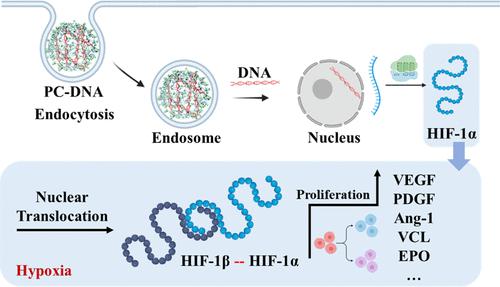当前位置:
X-MOL 学术
›
ACS Appl. Bio Mater.
›
论文详情
Our official English website, www.x-mol.net, welcomes your
feedback! (Note: you will need to create a separate account there.)
Poly(ethylenimine)-Cyclodextrin-Based Cationic Polymer Mediated HIF-1α Gene Delivery for Hindlimb Ischemia Treatment
ACS Applied Bio Materials ( IF 4.6 ) Pub Date : 2024-01-31 , DOI: 10.1021/acsabm.3c01020 Jingyu Li 1 , Zhuoting Lu 1 , Liwang Xu 1 , Jing Wang 2 , Shaojie Qian 3 , Qinglian Hu 1 , Yunfen Ge 3
ACS Applied Bio Materials ( IF 4.6 ) Pub Date : 2024-01-31 , DOI: 10.1021/acsabm.3c01020 Jingyu Li 1 , Zhuoting Lu 1 , Liwang Xu 1 , Jing Wang 2 , Shaojie Qian 3 , Qinglian Hu 1 , Yunfen Ge 3
Affiliation

|
Hindlimb ischemia is a common disease worldwide featured by the sudden decrease in limb perfusion, which usually causes a potential threat to limb viability and even amputation or death. Revascularization has been defined as the gold-standard therapy for hindlimb ischemia. Considering that vascular injury recovery requires cellular adaptation to the hypoxia, hypoxia-inducible factor 1 α (HIF-1α) is a potential gene for tissue restoration and angiogenesis. In this manuscript, effective gene delivery vector PEI-β-CD (PC) was reported for the first application in the hindlimb ischemia treatment to deliver HIF-1α plasmid in vitro and in vivo. Our in vitro finding demonstrated that PC/HIF-1α-pDNA could be successfully entered into the cells and mediated efficient gene transfection with good biocompatibility. More importantly, under hypoxic conditions, PC/HIF-1α-pDNA could up-regulate the HUEVC cell viability. In addition, the mRNA levels of VEGF, Ang-1, and PDGF were upregulated, and transcriptome results also demonstrated that the cell-related function of response to hypoxia was enhanced. The therapeutic effect of PC/HIF-1α-pDNA was further estimated in a murine acute hindlimb ischemia model, which demonstrated that intramuscular injection of PC/HIF-1α-pDNA resulted in significantly increased blood perfusion and alleviation in tissue damage, such as tissue fibrosis and inflammation. The results provide a rationale that HIF-1α-mediated gene therapy might be a practical strategy for the treatment of limb ischemia.
中文翻译:

聚(乙烯亚胺)-环糊精基阳离子聚合物介导的 HIF-1α 基因传递用于后肢缺血治疗
后肢缺血是一种世界范围内的常见疾病,其特征是肢体灌注突然减少,通常会对肢体活力造成潜在威胁,甚至截肢或死亡。血运重建被定义为后肢缺血的金标准治疗方法。考虑到血管损伤的恢复需要细胞对缺氧的适应,缺氧诱导因子1α(HIF-1α)是组织修复和血管生成的潜在基因。在这篇手稿中,报道了有效的基因递送载体 PEI-β-CD (PC) 首次应用于后肢缺血治疗,以在体外和体内递送 HIF-1α 质粒。我们的体外研究结果表明,PC/HIF-1α-pDNA可以成功进入细胞并介导有效的基因转染,并具有良好的生物相容性。更重要的是,在缺氧条件下,PC/HIF-1α-pDNA可以上调HUEVC细胞的活力。此外, VEGF 、 Ang-1 、 PDGF mRNA水平上调,转录组结果也表明细胞响应缺氧的相关功能增强。在小鼠急性后肢缺血模型中进一步评估了PC/HIF-1α-pDNA的治疗效果,结果表明肌肉注射PC/HIF-1α-pDNA可显着增加血液灌注并减轻组织损伤,例如组织损伤。纤维化和炎症。这些结果证明 HIF-1α 介导的基因治疗可能是治疗肢体缺血的实用策略。
更新日期:2024-01-31
中文翻译:

聚(乙烯亚胺)-环糊精基阳离子聚合物介导的 HIF-1α 基因传递用于后肢缺血治疗
后肢缺血是一种世界范围内的常见疾病,其特征是肢体灌注突然减少,通常会对肢体活力造成潜在威胁,甚至截肢或死亡。血运重建被定义为后肢缺血的金标准治疗方法。考虑到血管损伤的恢复需要细胞对缺氧的适应,缺氧诱导因子1α(HIF-1α)是组织修复和血管生成的潜在基因。在这篇手稿中,报道了有效的基因递送载体 PEI-β-CD (PC) 首次应用于后肢缺血治疗,以在体外和体内递送 HIF-1α 质粒。我们的体外研究结果表明,PC/HIF-1α-pDNA可以成功进入细胞并介导有效的基因转染,并具有良好的生物相容性。更重要的是,在缺氧条件下,PC/HIF-1α-pDNA可以上调HUEVC细胞的活力。此外, VEGF 、 Ang-1 、 PDGF mRNA水平上调,转录组结果也表明细胞响应缺氧的相关功能增强。在小鼠急性后肢缺血模型中进一步评估了PC/HIF-1α-pDNA的治疗效果,结果表明肌肉注射PC/HIF-1α-pDNA可显着增加血液灌注并减轻组织损伤,例如组织损伤。纤维化和炎症。这些结果证明 HIF-1α 介导的基因治疗可能是治疗肢体缺血的实用策略。




















































 京公网安备 11010802027423号
京公网安备 11010802027423号